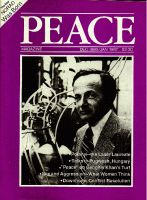
Peace Magazine Dec 1986-Jan 1987, page 32. Some rights reserved.
Search for other articles by Walter Dorn here
IN 1978 THE GOVERNMENT OF FRANCE PROPOSED a bold, new project that would introduce a significant peacekeeping element into the global political arena and would serve to strengthen the United Nations. The proposal was made at the first United Nations Special Session on Disarmament (UNSSOD I). So creative and compelling was the idea that at the regular session of the General Assembly held later that year, the nations of the world voted 121-0 (and 18 abstentions) in favor of a resolution to make a study of the project. However, both superpowers were among those abstaining.
The essence of the idea was to establish a specialized U.N. agency called the International Satellite Monitoring Agency (ISMA) which could (1) verify arms control and disarmament agreements, (2) monitor crisis situations, and (3) serve the United Nations in its peacekeeping and development missions. The goal was to give the world as a whole, through the United Nations, the satellite technology that has become such an important part of the military establishments of the two superpowers. In other words, it would break the monopoly that the superpowers have in surveillance and space-based operations. In this light, it is easy to see why the U.S. and the USSR did not cooperate.
Now that other countires are launching satellites and building space programs (Canada has made space its number one scientific funding priority) the monopoly is being broken naturally. Satellite transmission is becoming more accessible. Already people have satellite dishes in their back- yards to pick up TV signals. The day will dawn when reconnaissance data will also be commonplace. The sooner the United Nations and peacekeepers around the world can benefit from the data produced by reconnaissance satellites, the sooner will be the stabilization that is envisaged.
The exact resolution of military optical and other reconnaissance devices is not known and is a very closely guarded secret. However, pictures are available which demonstrate a resolution good enough to distinguish a tank from a jeep (2 metres). There are many claims that the CIA Big Bird and KH-11 satellites have "close-look" cameras capable of achieving a resolution better than 20 centimetres, enough to read the license plate of a car. Technologies also exist to spy in the dark (infra-red sensors), to correct for atmospheric disturbances, and to enhance images from moving objects.
Due to the slow movement of international support for ISMA, France has proceeded with a "regional" reconnaissance satellite program together with Sweden and Belgium. The SPOT system (acronym for Systeme Probatoire Observation de la Terre) has already placed one satellite in orbit using an Ariane launcher in French Guiana. Other satellites are in production. The pictures will be commercially available and will have a resolution of 10 metres. The time is ripe to re-introduce the notion of an international peacekeeping satellite program to governments and to consider the establishment of a specialized United Nations agency. Such an agency need not be costly to start and could grow naturally. The first phase of the program could simply be the creation of a data analysis centre which could interpret commercially available data, such as that from the SPOT satellite.
The need for such an agency is quite apparent. Just imagine a baseball game without an umpire to make the calls or a community without a police patrol to keep law and order. Yet this is the type of community in which the countries of the world live. Some sort of surveillance system is becoming increasingly necessary.
It would be necessary to establish a monitoring organization which is not responsible to any one particular country, one that could be seen as reliable and trustworthy. The United Nations is unique in our world to take on this role. Its purpose is to work for world peace and security. With member states from every part of the world, it has developed credibility and is respected. With mechanisms for peacekeeping already in place, the United Nations would be in the best position to handle the responsibilities of dealing with potentially very sensitive data.
The U.N. study completed in 1982 was entitled, "Implications of Establishing an International Satellite Monitoring Agency" (available as a U.N. sales publication E.83.IX.3). The 120-page report stated that verification of disarmament treaties by satellite is technically feasible, that it is not prohibited by international law (including space law) and that given various possible avenues for development it could be financially feasible. Even the most comprehensive program for an International Satellite Monitoring Agency with four satellites would cost each year well under one percent of the global expenditure on armaments.
In a time when billions of dollars are being spent to militarize space, isn't it time to think about using our final frontier for peacekeeping? We could use the same technologies to slow the arms race, to monitor agreements, and to build a base upon which agreements can be made.

Peace Magazine Dec 1986-Jan 1987, page 32. Some rights reserved.
Search for other articles by Walter Dorn here